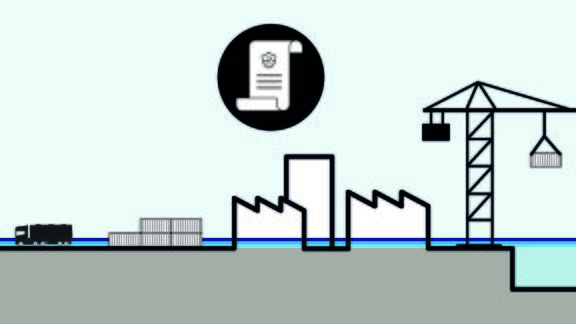Area emergency plan
An area emergency plan provides coordination and orchestration between individual companies and their company emergency plans. An area emergency plan states who is responsible for what, and the arrangements for chain dependencies.
• Always applicable;
• Crisis management;
• Emergency plan measure;
• Small investment;
• Prevents economic and environmental damage, and casualties;
• Applicable at all flood depths.

A company emergency plan includes all actions and protocols for communications, evacuation, shutdown and restart. In addition to documenting these actions, there should be periodical (for example, annual) drills with the plan so that it is known in the company how you can help to limit the damage in the event of a flood. In addition to emergency plans, officers from the company emergency services are needed to evacuate employees when there is a flood threat.
You can also involve utility companies and other suppliers of vital facilities or materials in the development of an area emergency plan. By discussing and defining the sequence for shutting down companies in advance, you can tailor your company emergency plan accordingly and limit the negative effects of a flood.
Making agreements about controlled disconnection procedures
In the event of a flood, it is important not to shutdown the electricity supply immediately. Terminals need power to stop processes in a controlled way. For example, you need electricity to de-gas tanks or flare products to prevent them from solidifying and resulting in massive damage. A plan should be drafted in advance that includes the sequence for the shutdown procedure and restarting businesses. It should take mutual dependencies into account.
Other relevant components of an area emergency plan include:
- The coordinated integration of actions to be taken by businesses and local government authorities with respect to flood risks. Who initiates what and in what order will these actions be taken?
- Coordination of when and how the grid operator will cut off the power supply;
- Communications: who informs whom and when?
- How quickly can shutdowns take place?
- How long will there be backup power facilities?
- How much time do companies need for controlled shutdowns?
- How many additional transportation movements are expected for the removal of materials and/or products, for example, from the area?
- Which critical emergency facilities (emergency generator/nitrogen supply) are needed for the continuation of operations and/or a controlled shutdown?
- Where can scarcity arise when decisions are made and/or action is taken? Consideration should be given here to acquiring emergency generators or other emergency supplies;
- Are logistical measures feasible, is the capacity available to implement logistical measures and/or is the area accessible?
- Who manages the plan, which agreements will be made and how will the plan be practised?
Deployment of vessels for evacuation
You can use vessels to evacuate people and goods. You will have to organise this depending on the specific circumstances when there is a flood or a flood threat. However, you can prepare by, for example, identifying the type of vessel you could deploy in a particular flood scenario and which types of goods or people you could evacuate by water.
Back to the overview.
You can take these measures to improve your flood protection. The focus here is on generic descriptions of the measures in question. If you have questions about applying the measures on your site, please contact the Flood Risk Management Team.
No rights can be derived from the measures. See also the disclaimer.